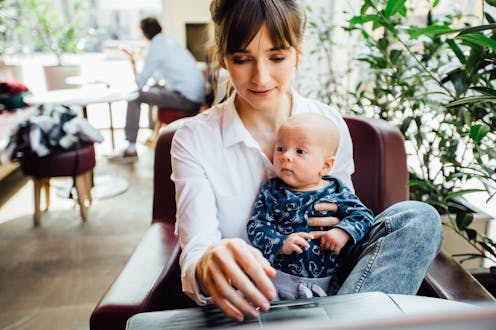Is the budget good for women? The paid parental leave change takes us backwards and childcare costs were ignored
- Written by Elizabeth Hill, Associate Professor Political Economy and Deputy Director, The Gender Equality in Working Life Research Initiative, University of Sydney

Among the many budget papers is the Women’s Budget Statement, a booklet outlining what the federal government is doing for Australian women. This includes A$2.1 billion for measures on domestic violence, women’s health, training and leadership.
As Prime Minister Scott Morrison and Women’s Minister Marise Payne write, the 2022 budget
demonstrates the Government’s continued commitment and action to achieving greater gender equality in Australia, and puts women at the centre of the economic and social recovery.
Does this stack up? One of the headline budget measures was an “enhanced” parental leave scheme. But the overhaul will not support gender equality in work and care. Meanwhile, the lack of reform to childcare is the biggest missed opportunity of the budget.
Paid parental leave
The budget combines two existing parental leave schemes into one. It merges two weeks of dad and partner pay with 18 weeks of parental leave pay (for the primary carer). Now, either parent can take the leave of up to 20 weeks in a bid to increase “choice and flexibility for families”.
This will especially benefit single parents, most of whom are women. But by removing the specific provision for dads and partners, it undoes good policy architecture designed to “nudge” men to take leave when a baby arrives.
Global research shows parental leave policies available to both parents on a “use it or lose it” basis deliver the best health and economic outcomes for children, women and men. These schemes mean dedicated leave for one parent cannot be taken by the other, pushing both parents to take leave to care.
Policy that supports the shared care of young children has been found to promote women’s participation in paid work and a more equitable division of unpaid care work over the long term.
Dad pay should not have been dumped
Global and Australian research also shows men are most likely to take parental leave when it is at income replacement level.
With the paid parental leave scheme paid at the national minimum wage rather than at wage replacement levels, there is a real risk men will not take up their new leave entitlement. Current cost-of-living pressures mean households are under increased economic strain and unable to afford any drop in income.
Read more: There's $1.3 billion for women's safety in the budget and it's nowhere near enough
So, the dad and partner pay should not have been dumped. Instead, it should have been developed to increase the incentives for men to take up more of the care load that will support women in the workforce, children’s health and men’s well-being.
This is on top of other necessary reforms - parental leave needs to be more generous in time and income. Superannuation also needs to be paid on the national scheme.
This will not change traditional caring roles
Even as the government removes the old categories of “primary” and “secondary” carer in the revised payment, the new scheme still risks entrenching Australian women as primary carers.
Australian women already do the majority of care and domestic work, and this is unlikely to shift without some strong incentives. The pandemic reminded us of just how “sticky” the unequal division of care work is as women shouldered the lion’s share of the pandemic care load.
The bottom line is this is not the kind of policy change that will drive an inclusive economic recovery and a gender equal economy.
Another blokes’ budget
As in previous years, this budget is focused on hard infrastructure such as cyber security, defence and traditional male trades.
These are important, but a better-balanced budget would deliver new investment in the essential care infrastructure our economy relies on. Countries such as Canada and the United States are developing new national care systems to drive productivity and an inclusive pandemic recovery.
A huge missed opportunity with childcare
This has been billed as a “cost-of-living” budget, but early childhood education and care have been overlooked. Even with a record spend of $10.3 billion this financial year, Australia has one of the most expensive early learning systems (for consumers) in the world. Childcare payments are one of the biggest costs to households, alongside housing costs and food.
A 2021 Mitchell Institute report found childcare is unaffordable for almost 40% of families. It is also difficult to access, especially in remote and regional areas.
This makes the $19.4 million allocation for 20 new childcare centres in known childcare “deserts” a welcome budget initiative. But much more is required.
There is widespread consensus amongst economists, business, civil society and community groups about the urgent need for free or more affordable early learning and care services for all children, regardless of what the parents do or do not do for work.
In The Conversation’s annual pre-budget survey of economists, one-third of respondents agreed increasing public subsidies for early learning and care was an appropriate way to spend money, even if it added to the deficit.
Investment in early learning is a key productivity measure – it will drive the pandemic recovery and support women to work at a level that suits their skills and aspirations. It is also a critical investment in our future, supporting all kids to have the best start in life no matter what their background.
Our system is not working for families and children, and this budget just tinkers at the sidelines.
Authors: Elizabeth Hill, Associate Professor Political Economy and Deputy Director, The Gender Equality in Working Life Research Initiative, University of Sydney





